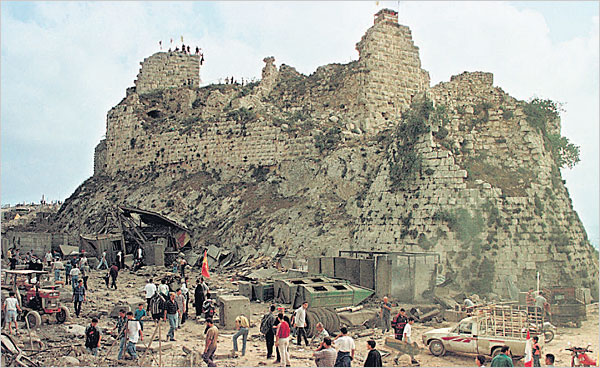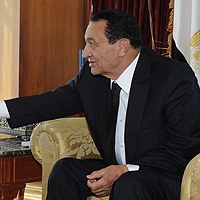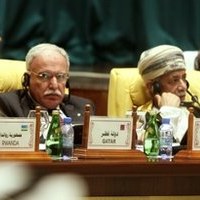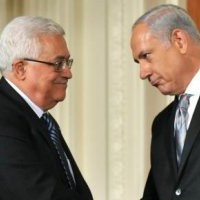![]()
Tue, June 21, 2011 | The Meir Amit Intelligence and Terrorism Information Center | By Reuven Erlich
Israel’s Unilateral Withdrawals from Lebanon and the Gaza Strip: A Comparative Overview
This essay is based on a lecture delivered by Reuven Erlich at the conference “The Withdrawal from Lebanon: Ten Years Later,” which took place at the Institute for National Security Studies on June 28, 2010. Translated into English by the INSS.
Introduction
In the last decade, Israel unilaterally withdrew from two areas: the security zone in southern Lebanon and the Gaza Strip. Israel had previously withdrawn unilaterally from occupied territories without political agreements, but these two withdrawals were more significant and traumatic, both socially and politically, than any prior withdrawal. The time that has passed since these unilateral withdrawals affords us some historical perspective and allows us to compare them in terms of their outcomes and the processes they generated, both positive and negative. This perspective allows us to study the larger picture and trace influences that in the heat of the dramatic events were difficult to discern and assess.
When looking at Lebanon and Israel’s policies there, my approach is not purely academic or that of an historian who wrote a doctoral thesis on Israeli-Lebanese relations. I participated in some of the events in Lebanon, not as a decision maker but as a professional, whether in the course of my service in Israeli Military Intelligence, both in Tel Aviv and in the Northern Command, or in my position with the Ministry of Defense, as deputy to Uri Lubrani, Coordinator of Government Activities in Lebanon. My perspective today on Lebanon and the Gaza Strip is shaped by my position as Head of the Meir Amit Intelligence and Terrorism Information Center at the Israel Intelligence Heritage and Commemoration Center (IICC), which studies the various arenas that are points of origin for terrorist activity against the State of Israel.
Background to the Unilateral Withdrawals
On May 24, 2000, the IDF withdrew from Lebanon; the disengagement from Gaza took place in August 2005. Both withdrawals were unilateral, that is, were carried out without any agreements with a state entity (Lebanon) or a semi-state entity (the Palestinian Authority). In both instances, the IDF withdrew to an international border rather than to one security line or another. Neither withdrawal provided a fundamental solution to the problems Israel faced and that it continues to face in these arenas.
The withdrawal from Lebanon in 2000 was preceded by other unilateral withdrawals undertaken without agreements or political arrangements (though it was the most significant of them). The IDF unilaterally withdrew to the Awali line during the IDF’s presence in Lebanon after the First Lebanon War and also withdrew to the Israeli-Lebanese border and established the security zone (January 1985). During its prolonged presence in Lebanon from the outbreak of the war and the subsequent gradual disengagements (1982-2000), Israel experienced a peace agreement with Lebanon that collapsed (the May 17, 1983 agreement), military talks that failed (the Nakura talks, November 1984-January 1985), and Israeli-Lebanese negotiations in Washington as part of the Madrid process, which ultimately went nowhere (1991-93). In all three cases, Syria, which became the sponsor of the Lebanese government after the First Lebanon War, made sure that Lebanon would not arrive at any sort of separate agreement with Israel independent of an Israeli-Syrian settlement.
The eighteen years between the IDF’s entrance into Lebanon in 1982 and its final withdrawal in 2000 were marked by Hizbollah waging war on Israel (and during the first years after its establishment, also on the United States and other Western targets). In the course of this fighting, Hizbollah, supported by Iran and Syria, developed guerilla and terrorist tactics, first and foremost suicide bombing attacks, abductions, and the use of powerful explosive charges against IDF troops, which were subsequently copied by Hamas and other Palestinian terrorist organizations.
The disengagement from the Gaza Strip was preceded by two extended terror campaigns that featured suicide bombers and a prominent role played by Hamas. In the 1990s the terror campaign was aimed at undermining the Oslo Accords, and during the so-called second intifada lethal suicide bombings were frequent and became the trademark of the campaign. The focal points for these campaigns were based primarily in Judea and Samaria rather than the Gaza Strip.
From the security perspective, there is an important difference between the IDF’s withdrawal from Lebanon and the disengagement from the Gaza Strip: the IDF left the security zone in Lebanon at the height of difficult fighting and after having sustained a series of severe blows (including the death of Brig. Gen. Erez Gerstein, commander of the Liaison Unit to Lebanon, and the helicopter disaster). Prime Minister Ariel Sharon’s announcement about the disengagement from the Gaza Strip (December 28, 2003) came at the height of the second intifada, as Israel was engaged in difficult warfare against Palestinian terrorism, but the implementation itself took place after the intifada had already declined (as a result of Operation Defensive Shield and the drop in suicide bombings, the death of Arafat, and Abu Mazen’s election).
The unilateral withdrawals from Lebanon and the Gaza Strip were first and foremost the product of the determined decision and execution of one person — Prime Minister Ehud Barak in the case of Lebanon and Prime Minister Ariel Sharon in the case of the Gaza Strip. Beyond the centrality of these two figures in the decisions, the withdrawals were also expressions of the fatigue of Israeli society and politics with the bloodshed in Lebanon and the prolonged preoccupation with Palestinian terrorism. The two withdrawals were carried out on the assumption at the time that the advantages of withdrawing would outweigh the advantages of the status quo, whether in Lebanon or the Gaza Strip.
At the regional level, the background to the withdrawal from Lebanon was the failure to achieve a political agreement with Syria that would also have solved the Lebanese problem (failure of the Shepherdstown talks in January 2000). In the Palestinian case, the background for the disengagement was the despair of arriving at a settlement with the PA in light of the Palestinian terrorism campaign. Regarding the Israeli-Lebanese issue, the political decision was preceded by social pressures from an extra-parliamentary movement that garnered a great deal of public support (the Four Mothers group, for example). There was no such parallel movement in the Palestinian context in general or the Gaza Strip context in particular.

A Palestinian woman flashes the victory sign as she celebrates the Israeli Army withdrawal from the Gaza Strip along with members of Hamas, Islamic Jihad and Fatah. (Photo: Marco di Lauro / Getty Images)
Hizbollah and Hamas: Similarities and Differences
Hizbollah and Hamas are movements deeply entrenched in, respectively, Lebanese and Palestinian society. Both were established in the 1980s — the former during the First Lebanon War (1982) and the latter at the outbreak of the first intifada (1987). Both exploited the weakness of the central government (be it the Lebanese regime or the PA) and effectively filled the governmental and military vacuums left by Israel after the withdrawals from Lebanon and the Gaza Strip.
Hizbollah and Hamas are both movements with sharp anti-Israel and anti-West radical Islamic ideologies and both can be characterized as profoundly jihadist in nature. Hizbollah embraced an Iranian-style radical Shiite Islamic ideology; this element constituted a central role in the organization’s establishment and continues to play a central role in its operation. Hamas, by contrast, is a radical Sunni Islamic movement with roots in the Muslim Brotherhood. Neither movement sprang out of thin air: Hizbollah was established in part as a result of longstanding religious and cultural links between the Shiite communities in Lebanon and Iran, which intensified after the fall of the shah in 1979. Hamas was established as an offshoot of the Muslim Brotherhood, which maintained an extensive social and religious infrastructure in the Gaza Strip and some centers of activity in Judea and Samaria (e.g., Hebron).
Several internal and regional circumstances contributed to the establishment and growth of Hizbollah and Hamas. The first was the waning of secular Arab nationalism, à la Nasser, and the rise of radical Islam, both in Lebanon and in the Palestinian Authority. The second was the success of the Islamic Revolution, which generated shockwaves throughout the region, and the rise of a radial Islamic regime in Iran that adopted a strategy of exporting the revolution (from the Iranian point of view, Lebanon was its most prominent success). Third was the civil war in Lebanon, which dealt a severe blow to the Christian community and the traditional Lebanese regime and increased the strength of the Shiite community, which had traditionally suffered from political, economic, and social discrimination. Fourth was the eradication of the PLO-Fatah military infrastructure in Lebanon during the First Lebanon War, creating in Lebanon, especially in the south, a military and governmental vacuum filled by Hizbollah. A fifth element was Palestinian criticism of the corruption within Fatah and among its senior personnel who returned to Judea and Samaria after the Oslo Accords (a decade after their expulsion from Lebanon).
Hizbollah in Lebanon and Hamas in the Palestinian Authority presented new models of terrorist organizations, different from their classical predecessors. These organizations’ terrorist activity represented only one of their fourfold foundations: the military-terrorist module, waging war on Israel in a variety of ways and means (from suicide bombing attacks to rocket fire at population centers); the political module, which prompted integration into the Lebanese and Palestinian regimes (while Hamas took over the Gaza Strip by force after the Israeli disengagement, Hizbollah in Lebanon has been careful to play by the rules); the social module, providing extensive social, religious, and educational services to the population, thereby filling the vacuum left by the state; and the media module, based on a media empire of TV, radio, internet, and newspapers, given the importance of winning the battle for the hearts and minds of the population.
To these one may add another unique dimension characterizing Hizbollah, namely the Shiite sectarian aspect, which has great significance in light of the sectarian nature of Lebanese society and politics. This is absent in Hamas, which operates within a much more homogeneous Sunni Muslim population.
The Role Played by Iran and Syria
Hizbollah is the handiwork of Iran and serves as a tool to promote Iran’s strategic goals. The organization was established during the First Lebanon War (summer 1982) in the Beqaa Valley in Lebanon by the Iranian Revolutionary Guards, with Syrian encouragement and assistance. From the outset, it was possible to define Hizbollah as an Iranian project, undertaken in close coordination with Syria. While Hizbollah also wears a “Lebanese hat” and is integrated into Lebanese society and politics, it is the “Iranian hat” that dominates and ultimately dictates its ideology, policies, and nature.
With the Hamas movement, the picture is somewhat more complex. The movement receives massive assistance form Iran, in terms of weapons, financing, and training. At the same time, however, there is a basic, inherent tension between Hamas and Iran, stemming from the conflict between radical Shiite Islam and Iran’s ambitions for hegemony over the Middle East on the one hand, and Arabism and radical Sunni Islam, home to Hamas, on the other. Senior Hamas figures, led by Khaled Mashal, operate out of Damascus and from there steer the organization’s terrorist and political activities, and Hamas depends heavily on Syrian political and military assistance.
Expectations were that the withdrawal from Lebanon would weaken Syria and ease the pressure it exerted via Hizbollah on Israel. In hindsight, the withdrawal did in fact weaken Syria’s status in Lebanon but strengthened that of Iran, both in Lebanon and in the Gaza Strip. At a later stage, after Syria overcame the difficulties created by the withdrawal of its army from Lebanon, it again became an important player in the Lebanese arena.
In retrospect, it is clear that the withdrawals from the security zone in southern Lebanon and from the Gaza Strip amplified the importance of Hizbollah and Hamas in the eyes of Iran and Syria. The withdrawals also increased the ability and motivation of those two states to use Hizbollah and Hamas as their proxies to exert pressure on Israel, not only through intermittent fighting with the IDF but also by threatening the civilians in Israel’s home front by means of the rockets stockpiled with their support in Lebanon and the Gaza Strip. Beyond their routine use, these rockets are supposed to be activated against Israel on “the day of reckoning” in accordance with the regional strategic interests of Iran and Syria.
The Territory and the Population
In Lebanon and the Gaza Strip the IDF undertook full withdrawals, i.e., to the international border (which does not prevent Hamas and its supporters from claiming that the Gaza Strip is still occupied by Israel). In both cases, the step was taken unilaterally, without the agreement of the Lebanese government or the PA, as the assessment of the Israeli decision makers was that there was no realistic chance of achieving such agreements. In both cases, the State of Israel rejected the option of retaining a “security zone.” In Lebanon, the South Lebanon Army (SLA) had stopped existing and the IDF did not leave outposts of tactical importance in the security zone. In the Gaza Strip, no Israeli military positions or settlements were left. Even the Philadelphi Axis along the Egyptian-Israeli border, where presence is important for preventing arms smuggling into the Gaza Strip, was evacuated by the IDF.
Nonetheless, there is a basic difference between Lebanon and the Gaza Strip that has influenced the responses by the UN and the international community to the withdrawals: after the withdrawal from Lebanon, the IDF deployed on a recognized international border (along the Blue Line) with no loose ends (the issues of the village of Rajar and Shab’a Farms are unconnected to the Israeli-Lebanese border question; they are linked to the unmarked Lebanese-Syrian border). In the Palestinian arena, however, there was an expectation of further withdrawals in Judea and Samaria, in addition to the withdrawal from the northern part of Samaria that took place in conjunction with the disengagement from the Gaza Strip. However, given the problematic results of the two unilateral withdrawals and the lack of progress in the negotiations over the Israeli-Palestinian conflict, no further unilateral withdrawals occurred.
In addition, both withdrawals entailed difficulties and complications in that the areas were home to population groups that ultimately paid a steep price. In Lebanon there were no Israeli settlements, but the so-called security zone was inhabited by Christian, Shiite, and Druze populations, some of whom became SLA soldiers. They and their families out of mutual interests that became evident during the Lebanese civil war had fought alongside the IDF since 1976. As a result of the IDF’s withdrawal from Lebanon, 6,800 people fled into Israel, most of them SLA soldiers and their families. Over time, some 4,000 of those who fled either returned to Lebanon or left for destinations abroad, while some 2,800 remained in Israel. In the Gaza Strip there was no local Palestinian militia such as the SLA, but there were some 8,600 Jewish settlers who found themselves uprooted from the villages where they had built their communities and homes.
Both population groups were particularly traumatized by the Israeli withdrawals, although the decisions were inevitable: it was impossible to maintain the SLA over the long term in the security zone or the Jewish settlements in the Gaza Strip without the presence of the IDF. Similarly, the pictures of SLA refugees massing on the northern border crossing and the evacuation of the Jewish residents from the Gaza Strip were traumatic for Israeli society. The State of Israel invested massive resources to deal with these two groups, but the treatment has been ineffective for a number of reasons. In both cases, Israel failed to deal properly with those who paid the price, which should have been done without regard to one political orientation or another. Israel showed determination in implementing the military aspect of the withdrawal from Lebanon and carried it out successfully without casualties, but it did not employ the same determination and effectiveness in rehabilitating SLA refugees or those who were evacuated from the Gaza Strip settlements.
Post-Withdrawal Processes in Lebanon and the Gaza Strip
The withdrawals from Lebanon and the Gaza Strip were seen by the Lebanese, Palestinians, and the Arab world in general as evidence of Israeli weakness resulting from the pressures of terrorism and the weakened stamina of Israeli society. The events, therefore, had a negative impact on the image of Israel, the IDF, and Israeli society. The “spider web” metaphor coined by Hizbollah Secretary General Hassan Nasrallah in the May 26, 2000 speech in Bint Jbail was widely accepted in the Arab world for at least a few years (the Second Lebanon War and the end of the second intifada actually demonstrated Israel’s stamina when it is pushed to the wall).
An analysis of the two arenas after the IDF withdrawals reveals certain negative developments and processes. While the withdrawals themselves did not cause them, they did contribute to their acceleration. The first process occurred at the political level. The political weight of Hizbollah and Hamas has grown in the intra-Lebanese and intra-Palestinian politics and in the Arab world in general. Hizbollah has increased its representation in the Lebanese parliament and emerged as a terrorist organization enjoying political legitimacy and wielding a great deal of influence on government decisions. For its part, Hamas participated in the January 5, 2006 elections for the Palestinian Legislative Council (less than six months after the disengagement) and won by a landslide. By June 2007 it lost patience and took over the Gaza Strip by force, in what has been described by the PA as a military coup. This move de facto created two separate Palestinian entities, one in the West Bank and the other in the Gaza Strip, and the political and social gaps between them grew steadily wider.
The second process entailed the construction of military infrastructures: the withdrawals from Lebanon and the Gaza Strip were exploited to build extensive military infrastructures with the support of Iran and Syria. Unprecedented amounts of weapons were smuggled from Iran and Syria into Lebanon and the Gaza Strip, reaching Hizbollah Hamas, and other terrorist organizations. Israel and the international community found this difficult to contain. The infrastructure that has been built includes the capabilities to launch rockets that threaten the heart of the State of Israel. Hizbollah has more than 40,000 rockets, while Hamas has several thousands at its disposal. While rocket fire was a part of life in northern Israel and the western Negev towns even before the unilateral withdrawals, there has been a significant change for the worse in terms of the quantity and quality of the rockets and other weapons at the disposal of Hizbollah and Hamas. Before Israel withdrew from Lebanon the rocket range encompassed Kiryat Shmona, Safed, Nahariya, and Sderot; today greater Tel Aviv is also within range – both from the north and from the south.
The third process is continued terrorist activity. Israel’s declarations that after its unilateral withdrawals it would respond quickly and decisively to terrorist attacks did not stand the test of reality. Neither withdrawal ended terrorism, and Israel’s “proportionate” responses in both arenas did nothing to restrain terrorist activity. On the contrary, they were often seen as reflections of weakness. Of particular importance was the abduction of three IDF soldiers at Mt. Dov in October 2000, some five months after the withdrawal, without any significant Israeli response (for reasons having to do with giving preference to the Palestinian arena, which was already engaged in a terrorist campaign, the second intifada). After the disengagement, there was a dramatic increase in Hamas rocket fire directed at Israel from the Gaza Strip, which did not incur severe repercussions until Operation Cast Lead. In the northern part of Samaria, the security situation improved after the withdrawal, though not necessarily as a result of evacuating the Jewish settlements there, rather because of the end of the second intifada, the construction of the security fence, and preventive activity by Israel and the PA security services after Operation Defensive Shield.
The withdrawal from Lebanon did not itself prompt the outbreak of the second intifada some four months later. Rather, the second intifada was caused by a host of factors stemming from difficulties in the peace process, Arafat’s personality, the growing strength of Palestinian terrorist organizations, and Israel’s longstanding occupation of Palestinian areas. However, the image of the State of Israel and Israeli society as weak and willing to undertake unilateral withdrawals to international borders as the result of the pressure of terrorism (an image that during the second intifada proved incorrect) perhaps contributed to the Palestinians’ decision to prefer terrorism over political negotiations.
Hizbollah and Hamas were naturally accorded credit for ejecting Israel from Lebanon and the Gaza Strip, as they ostensibly succeeded in causing the withdrawals by means of a terrorist and guerilla campaign (“the resistance”). Neither organization stopped its armed struggle against Israel after the withdrawals, though its nature changed: Hizbollah lowered its profile after the withdrawal from Lebanon, while Hamas raised it by exchanging suicide bombing attacks for rocket fire aimed at civilian centers in the western part of the Negev.
Two “corrective” wars — the Second Lebanon War some six years after the withdrawal from the security zone, and Operation Cast Lead some three and a half years after the disengagement — were needed for the State of Israel to be able to reap the (albeit imperfect) security benefits of the unilateral withdrawals. Herein, therefore, lies an additional important lesson: the need to back up Israeli withdrawals, especially if unilateral, with a big stick, including at times military moves, particularly if the other side persists in terrorist activity and, as was the case with Hamas, increases it.
Domestic and International Ramifications
The withdrawal from Lebanon won almost unanimous support within Israel, and a great sigh of relief accompanied the exit from the “Lebanese swamp.” The difficulties of SLA soldiers and their families in resettling in Israel, the sporadic terrorist attacks that continued from the Lebanese border, and Hizbollah’s accelerated military buildup all escaped exceptional social and political criticism by Israel, which was preoccupied with a bloody confrontation with the Palestinians and aimed to contain Hizbollah attacks along the Lebanese border. It was only the Second Lebanon War that made people question the wisdom of the unilateral withdrawal in 2000. The disengagement was different. It caused a significant crisis within Israel and a crisis of trust between some segments of religious Zionists and the state, with wounds that to this day have remained open. The ineffective handling of rebuilding the life of those evacuated from the Gaza Strip only heightened the anger and frustration. This has implications for many areas, but this discussion lies beyond the scope of this essay.
One of the most important — albeit underplayed, if not outright ignored — differences between the withdrawals is that the withdrawal from Lebanon was accompanied by intensive political efforts that generated a supportive UN and international environment, whereas the withdrawal from the Gaza Strip lacked such efforts.
In the Lebanese arena, Israel managed to enlist support from the UN and the United States: leaving Lebanon occurred in the context of Security Council Resolution 425 (1978), preceded by dialogues with UN Secretary General Kofi Anan and the UN Secretariat. This dialogue produced the demarcation of the Blue Line (on the basis of the international border) by UN cartographers, and the UN formally confirmed that Israel had indeed withdrawn to the international line. Prior political dialogue also took place with the United States, which supported the withdrawal and lent it political backing.
By contrast, no similar process was undertaken on the eve of the disengagement from the Gaza Strip. In retrospect, this emerges as a serious mistake that lies at the core of the significant differences in the results of the two unilateral withdrawals: the international community recognized that Israel had abided by Security Council Resolution 425, and the efforts of the Lebanese government to challenge the demarcation of the Blue Line or the attempts by Hizbollah and the Lebanese to foment trouble over Shab’a Farms did not change the international community’s support for the Israeli move. Moreover, the Second Lebanon War ended with Security Council Resolution 1701, which states that the Lebanese government must impose its authority and control over southern Lebanon and prohibits the presence of terrorists and weapons not under control of the Lebanese army. The resolution also reaffirms the Blue Line drawn by the UN when the IDF withdrew from Lebanon. Resolution 1701 and the deterrence Israel achieved have contributed to the unprecedented calm on the Israeli-Lebanese border (although it is exploited by Hizbollah to accelerate its military buildup, including significant expansion of its rocket stockpiles, with Iranian and Syrian support).
By contrast, Operation Cast Lead ended without a Security Council resolution, and for good reason. The situation in the Gaza Strip differs from the one in Lebanon. To this day, political and legal arguments are made to the effect that Israel has not completely withdrawn from the Gaza Strip, as it controls the crossings, skies, and seas and continues therefore to be responsible for the population. Israel’s attempts to shrug this off have not always been successful and have been rebuffed on the international arena.
As a result, the status of the State of Israel internationally is much more solid on the Lebanese question than it is on the Gaza Strip: the support of the international community has become an inseparable part of what constitutes Israel’s deterrence capability in Lebanon, it backs up the unprecedented calm on the Israeli-Lebanese border, and allows Israel greater scope to act there. One could go further and say: it was no accident that no Goldstone-type report was composed after the Second Lebanon War and that no aid flotillas sail to help the Shiites of southern Lebanon; it is no accident that world public opinion does not support the conduct of Hizbollah in Lebanon. The way Israel left Lebanon had an important effect, and it is clear that the UN is an element that must be taken into consideration. The lesson is that in every military operation or military-political step such as a unilateral withdrawal, there is a greater need to take into account the stances of the UN, the international community, and world public opinion.
Conclusion
The withdrawal from Lebanon and the disengagement from the Gaza Strip demonstrated that a unilateral withdrawal is not a magic formula for achieving what diplomats have failed to attain (peace agreements with Syria and Lebanon) or can attain (an agreement with the PA). Nonetheless, one cannot ignore the positive results that the unilateral withdrawals brought in their wake, especially in the Lebanese arena. Israel extricated itself from direct involvement in Lebanon, IDF losses dropped, and the intensity of the fighting on the Israeli-Lebanese border abated (before the Second Lebanon War and more so afterwards). This allowed Israel to focus on the serious problems in the Palestinian arena and to avoid a comprehensive confrontation on both fronts.
The picture emerging from the comparison between the two withdrawals is complex and not unequivocal, and it is possible to point to advantages and disadvantages to the withdrawals in both arenas. However, from a strategic perspective one may conclude that Israel has not altogether left either the “Lebanese swamp” or the “Gaza swamp,” because fundamental changes in Israel’s relations with its neighbors cannot be attained by unilateral withdrawals but only by political agreements backed by the willingness to use military force when necessary, and by support of the international community. This is an important lesson and it behooves Israel to learn it well.
Col. (ret.) Dr. Reuven Erlich is Head of the Meir Amit Intelligence and Terrorism Information Center at the Israel Intelligence Heritage and Commemoration Center (IICC).



 RSS
RSS











Israel’s Unilateral Withdrawals from Lebanon and the Gaza Strip: A Comparative Overview | #Israel #Gaza #Lebanon http://bit.ly/jRkoup
Israel’s Unilateral Withdrawals from Lebanon and the Gaza Strip: A Comparative Overview | #Israel #Gaza #Lebanon http://bit.ly/jRkoup